Business in Practice: Exploring Business Types, Structures & PESTLE
VerifiedAdded on 2023/01/04
|12
|2710
|47
Report
AI Summary
This report provides an overview of different business types based on size (micro, small, medium, and large) and ownership (sole proprietorship, partnership, limited liability, public limited liability, and cooperative). It identifies various organizational structures, including flat and hierarchical structures, and explains how these structures affect business productivity, using Marks & Spencer as an example. Furthermore, the report utilizes PESTLE analysis to evaluate the impact of political, economic, social, technological, legal, and environmental factors on business performance, highlighting the importance of understanding these external influences for sustainable growth. Desklib provides this and many other solved assignments for students.
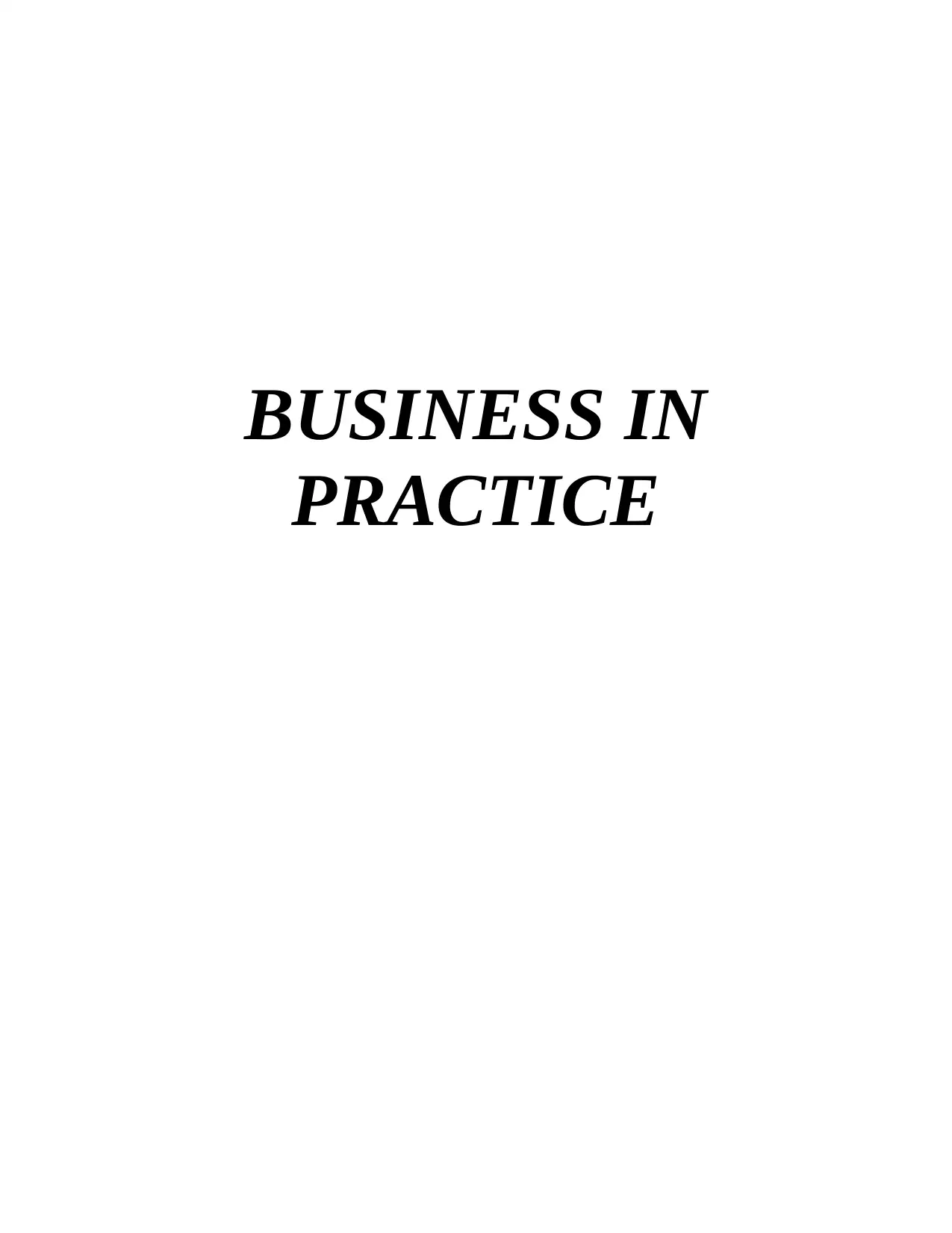
BUSINESS IN
PRACTICE
PRACTICE
Paraphrase This Document
Need a fresh take? Get an instant paraphrase of this document with our AI Paraphraser
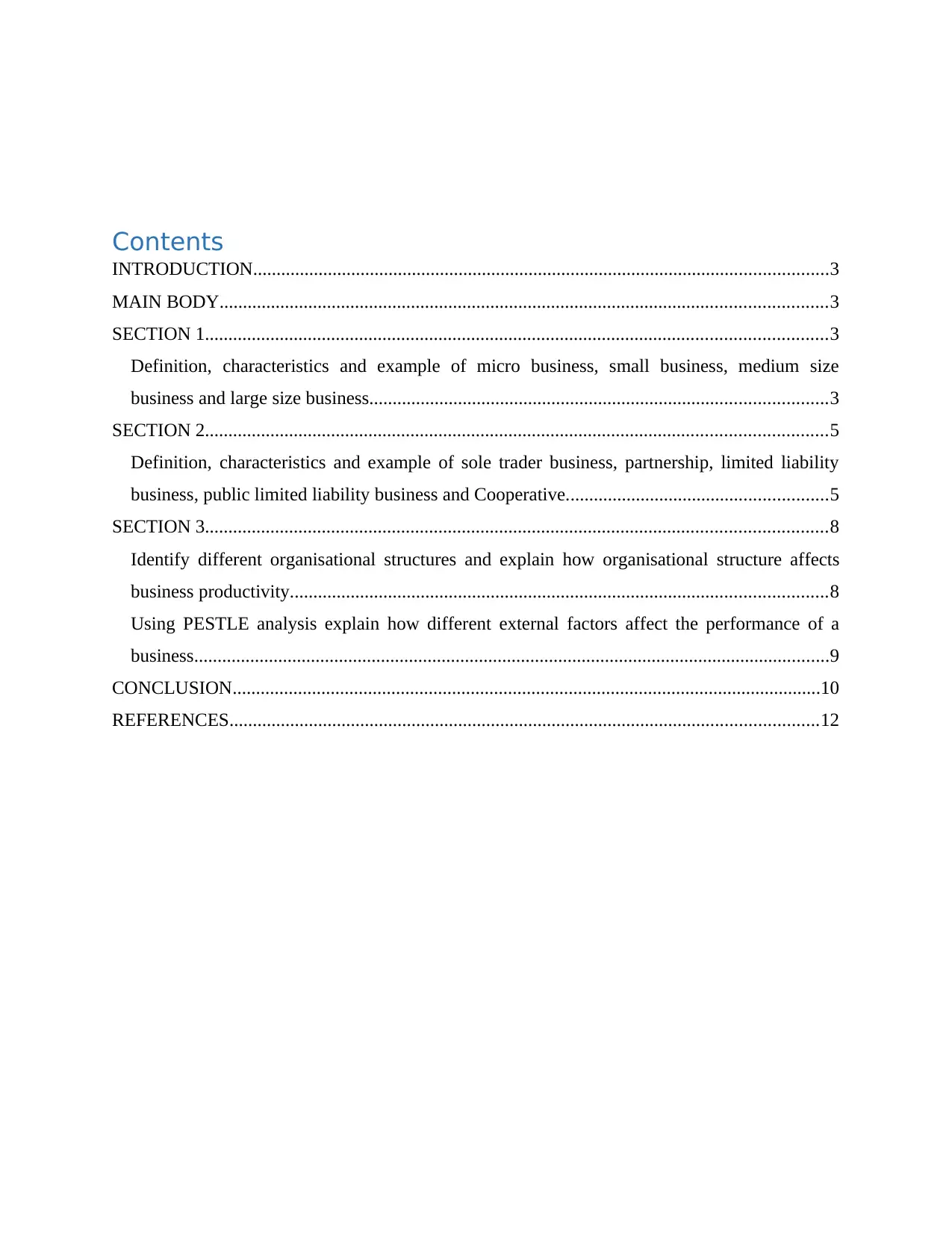
Contents
INTRODUCTION...........................................................................................................................3
MAIN BODY..................................................................................................................................3
SECTION 1.....................................................................................................................................3
Definition, characteristics and example of micro business, small business, medium size
business and large size business..................................................................................................3
SECTION 2.....................................................................................................................................5
Definition, characteristics and example of sole trader business, partnership, limited liability
business, public limited liability business and Cooperative........................................................5
SECTION 3.....................................................................................................................................8
Identify different organisational structures and explain how organisational structure affects
business productivity...................................................................................................................8
Using PESTLE analysis explain how different external factors affect the performance of a
business........................................................................................................................................9
CONCLUSION..............................................................................................................................10
REFERENCES..............................................................................................................................12
INTRODUCTION...........................................................................................................................3
MAIN BODY..................................................................................................................................3
SECTION 1.....................................................................................................................................3
Definition, characteristics and example of micro business, small business, medium size
business and large size business..................................................................................................3
SECTION 2.....................................................................................................................................5
Definition, characteristics and example of sole trader business, partnership, limited liability
business, public limited liability business and Cooperative........................................................5
SECTION 3.....................................................................................................................................8
Identify different organisational structures and explain how organisational structure affects
business productivity...................................................................................................................8
Using PESTLE analysis explain how different external factors affect the performance of a
business........................................................................................................................................9
CONCLUSION..............................................................................................................................10
REFERENCES..............................................................................................................................12
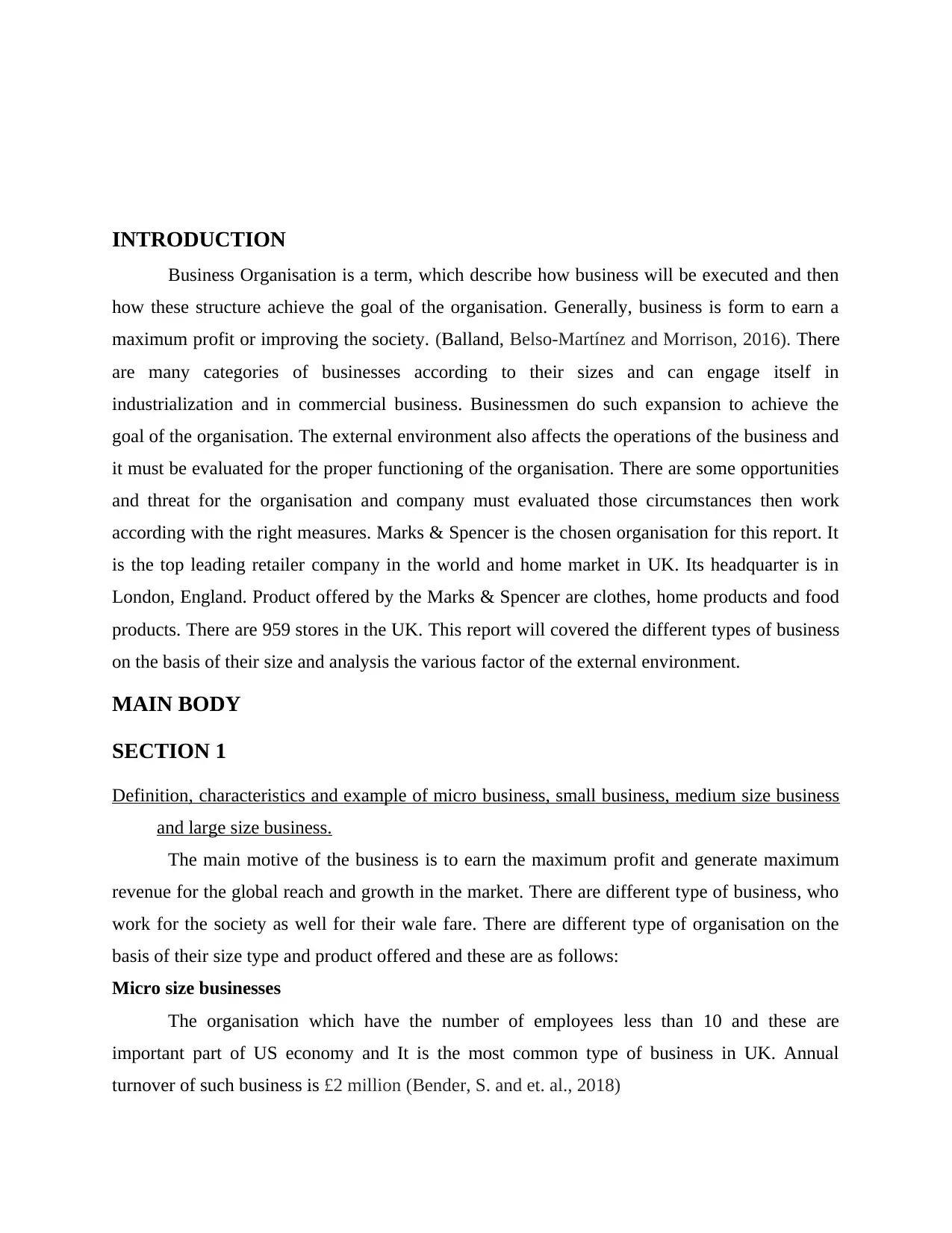
INTRODUCTION
Business Organisation is a term, which describe how business will be executed and then
how these structure achieve the goal of the organisation. Generally, business is form to earn a
maximum profit or improving the society. (Balland, Belso-Martínez and Morrison, 2016). There
are many categories of businesses according to their sizes and can engage itself in
industrialization and in commercial business. Businessmen do such expansion to achieve the
goal of the organisation. The external environment also affects the operations of the business and
it must be evaluated for the proper functioning of the organisation. There are some opportunities
and threat for the organisation and company must evaluated those circumstances then work
according with the right measures. Marks & Spencer is the chosen organisation for this report. It
is the top leading retailer company in the world and home market in UK. Its headquarter is in
London, England. Product offered by the Marks & Spencer are clothes, home products and food
products. There are 959 stores in the UK. This report will covered the different types of business
on the basis of their size and analysis the various factor of the external environment.
MAIN BODY
SECTION 1
Definition, characteristics and example of micro business, small business, medium size business
and large size business.
The main motive of the business is to earn the maximum profit and generate maximum
revenue for the global reach and growth in the market. There are different type of business, who
work for the society as well for their wale fare. There are different type of organisation on the
basis of their size type and product offered and these are as follows:
Micro size businesses
The organisation which have the number of employees less than 10 and these are
important part of US economy and It is the most common type of business in UK. Annual
turnover of such business is £2 million (Bender, S. and et. al., 2018)
Business Organisation is a term, which describe how business will be executed and then
how these structure achieve the goal of the organisation. Generally, business is form to earn a
maximum profit or improving the society. (Balland, Belso-Martínez and Morrison, 2016). There
are many categories of businesses according to their sizes and can engage itself in
industrialization and in commercial business. Businessmen do such expansion to achieve the
goal of the organisation. The external environment also affects the operations of the business and
it must be evaluated for the proper functioning of the organisation. There are some opportunities
and threat for the organisation and company must evaluated those circumstances then work
according with the right measures. Marks & Spencer is the chosen organisation for this report. It
is the top leading retailer company in the world and home market in UK. Its headquarter is in
London, England. Product offered by the Marks & Spencer are clothes, home products and food
products. There are 959 stores in the UK. This report will covered the different types of business
on the basis of their size and analysis the various factor of the external environment.
MAIN BODY
SECTION 1
Definition, characteristics and example of micro business, small business, medium size business
and large size business.
The main motive of the business is to earn the maximum profit and generate maximum
revenue for the global reach and growth in the market. There are different type of business, who
work for the society as well for their wale fare. There are different type of organisation on the
basis of their size type and product offered and these are as follows:
Micro size businesses
The organisation which have the number of employees less than 10 and these are
important part of US economy and It is the most common type of business in UK. Annual
turnover of such business is £2 million (Bender, S. and et. al., 2018)
⊘ This is a preview!⊘
Do you want full access?
Subscribe today to unlock all pages.

Trusted by 1+ million students worldwide
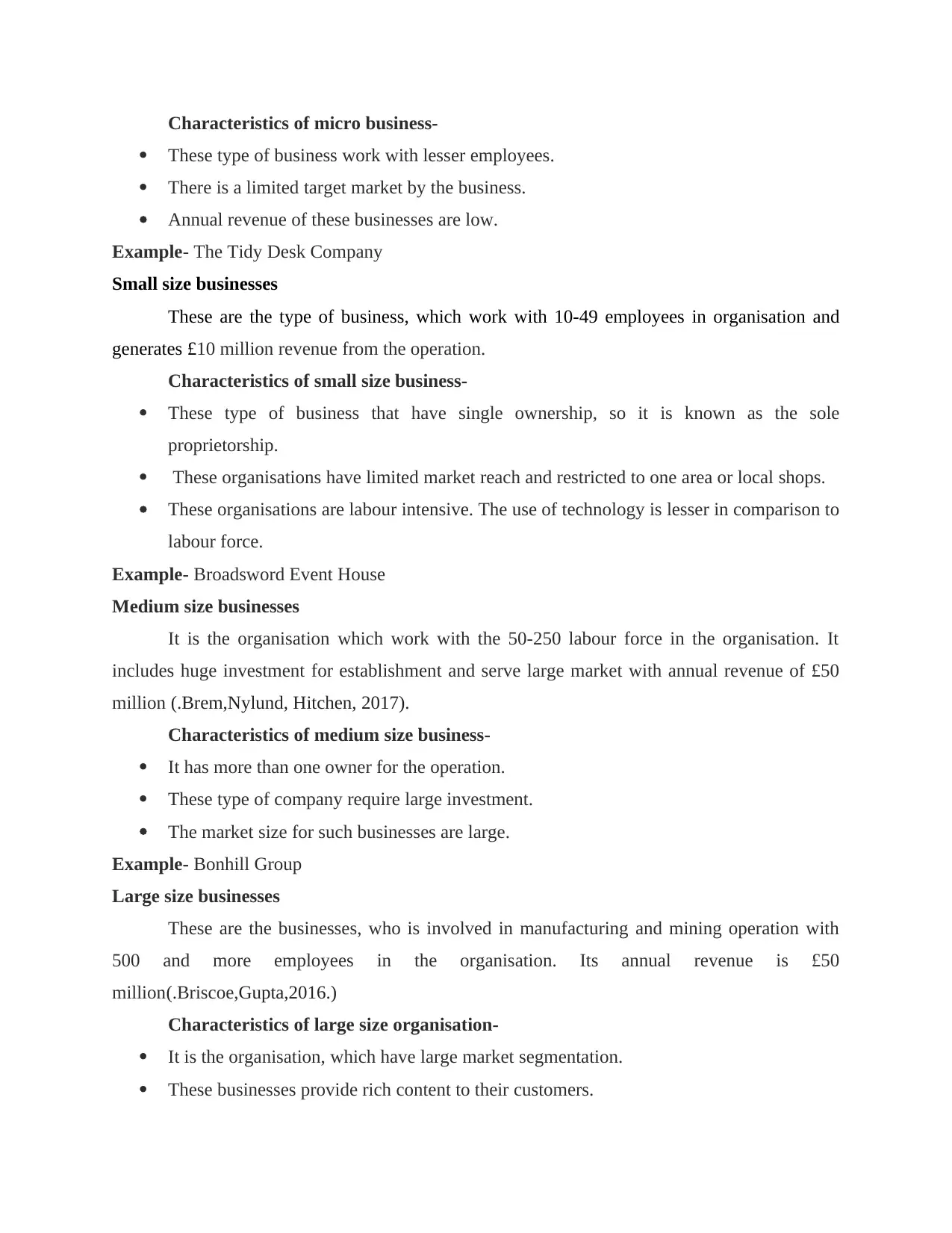
Characteristics of micro business-
These type of business work with lesser employees.
There is a limited target market by the business.
Annual revenue of these businesses are low.
Example- The Tidy Desk Company
Small size businesses
These are the type of business, which work with 10-49 employees in organisation and
generates £10 million revenue from the operation.
Characteristics of small size business-
These type of business that have single ownership, so it is known as the sole
proprietorship.
These organisations have limited market reach and restricted to one area or local shops.
These organisations are labour intensive. The use of technology is lesser in comparison to
labour force.
Example- Broadsword Event House
Medium size businesses
It is the organisation which work with the 50-250 labour force in the organisation. It
includes huge investment for establishment and serve large market with annual revenue of £50
million (.Brem,Nylund, Hitchen, 2017).
Characteristics of medium size business-
It has more than one owner for the operation.
These type of company require large investment.
The market size for such businesses are large.
Example- Bonhill Group
Large size businesses
These are the businesses, who is involved in manufacturing and mining operation with
500 and more employees in the organisation. Its annual revenue is £50
million(.Briscoe,Gupta,2016.)
Characteristics of large size organisation-
It is the organisation, which have large market segmentation.
These businesses provide rich content to their customers.
These type of business work with lesser employees.
There is a limited target market by the business.
Annual revenue of these businesses are low.
Example- The Tidy Desk Company
Small size businesses
These are the type of business, which work with 10-49 employees in organisation and
generates £10 million revenue from the operation.
Characteristics of small size business-
These type of business that have single ownership, so it is known as the sole
proprietorship.
These organisations have limited market reach and restricted to one area or local shops.
These organisations are labour intensive. The use of technology is lesser in comparison to
labour force.
Example- Broadsword Event House
Medium size businesses
It is the organisation which work with the 50-250 labour force in the organisation. It
includes huge investment for establishment and serve large market with annual revenue of £50
million (.Brem,Nylund, Hitchen, 2017).
Characteristics of medium size business-
It has more than one owner for the operation.
These type of company require large investment.
The market size for such businesses are large.
Example- Bonhill Group
Large size businesses
These are the businesses, who is involved in manufacturing and mining operation with
500 and more employees in the organisation. Its annual revenue is £50
million(.Briscoe,Gupta,2016.)
Characteristics of large size organisation-
It is the organisation, which have large market segmentation.
These businesses provide rich content to their customers.
Paraphrase This Document
Need a fresh take? Get an instant paraphrase of this document with our AI Paraphraser
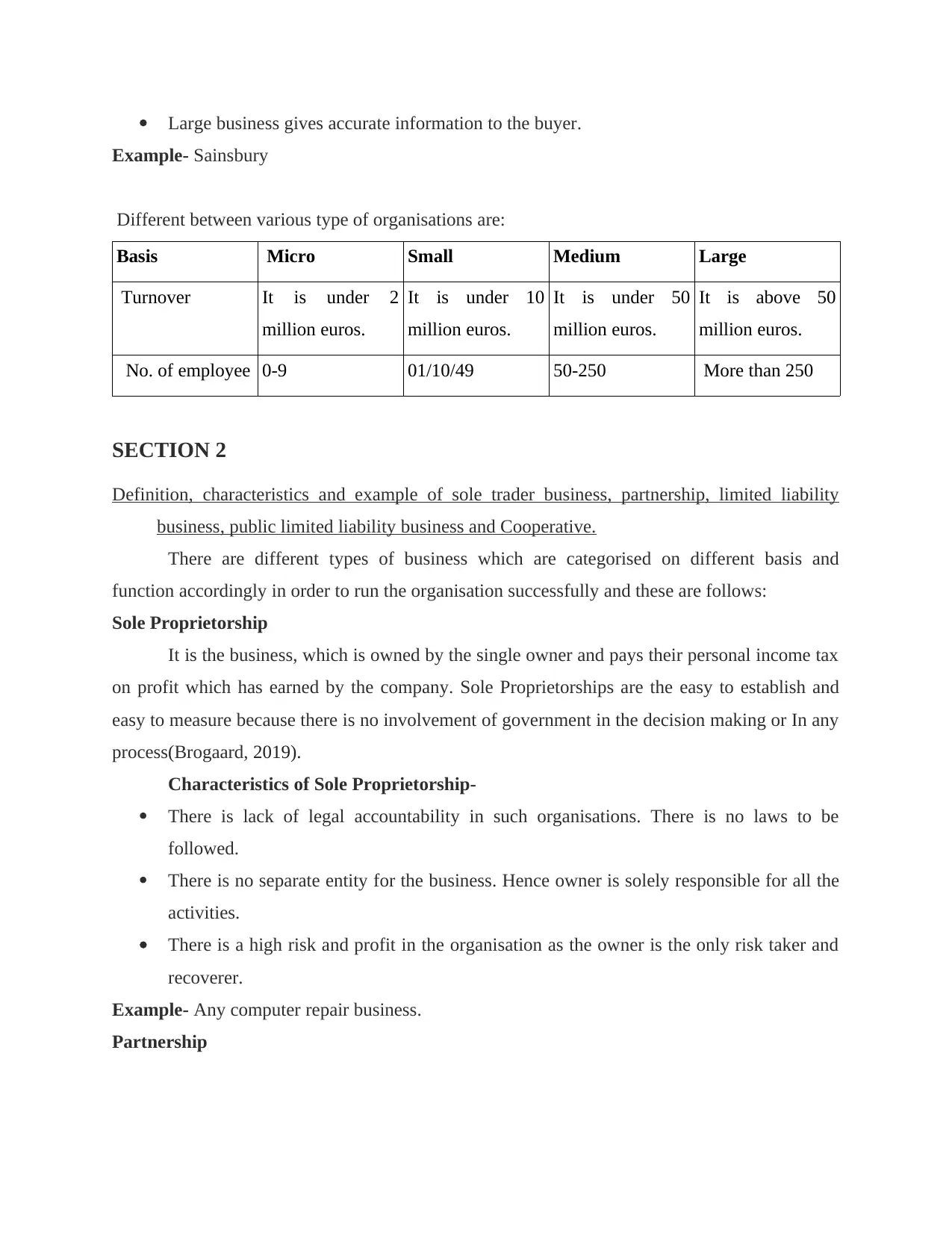
Large business gives accurate information to the buyer.
Example- Sainsbury
Different between various type of organisations are:
Basis Micro Small Medium Large
Turnover It is under 2
million euros.
It is under 10
million euros.
It is under 50
million euros.
It is above 50
million euros.
No. of employee 0-9 01/10/49 50-250 More than 250
SECTION 2
Definition, characteristics and example of sole trader business, partnership, limited liability
business, public limited liability business and Cooperative.
There are different types of business which are categorised on different basis and
function accordingly in order to run the organisation successfully and these are follows:
Sole Proprietorship
It is the business, which is owned by the single owner and pays their personal income tax
on profit which has earned by the company. Sole Proprietorships are the easy to establish and
easy to measure because there is no involvement of government in the decision making or In any
process(Brogaard, 2019).
Characteristics of Sole Proprietorship-
There is lack of legal accountability in such organisations. There is no laws to be
followed.
There is no separate entity for the business. Hence owner is solely responsible for all the
activities.
There is a high risk and profit in the organisation as the owner is the only risk taker and
recoverer.
Example- Any computer repair business.
Partnership
Example- Sainsbury
Different between various type of organisations are:
Basis Micro Small Medium Large
Turnover It is under 2
million euros.
It is under 10
million euros.
It is under 50
million euros.
It is above 50
million euros.
No. of employee 0-9 01/10/49 50-250 More than 250
SECTION 2
Definition, characteristics and example of sole trader business, partnership, limited liability
business, public limited liability business and Cooperative.
There are different types of business which are categorised on different basis and
function accordingly in order to run the organisation successfully and these are follows:
Sole Proprietorship
It is the business, which is owned by the single owner and pays their personal income tax
on profit which has earned by the company. Sole Proprietorships are the easy to establish and
easy to measure because there is no involvement of government in the decision making or In any
process(Brogaard, 2019).
Characteristics of Sole Proprietorship-
There is lack of legal accountability in such organisations. There is no laws to be
followed.
There is no separate entity for the business. Hence owner is solely responsible for all the
activities.
There is a high risk and profit in the organisation as the owner is the only risk taker and
recoverer.
Example- Any computer repair business.
Partnership
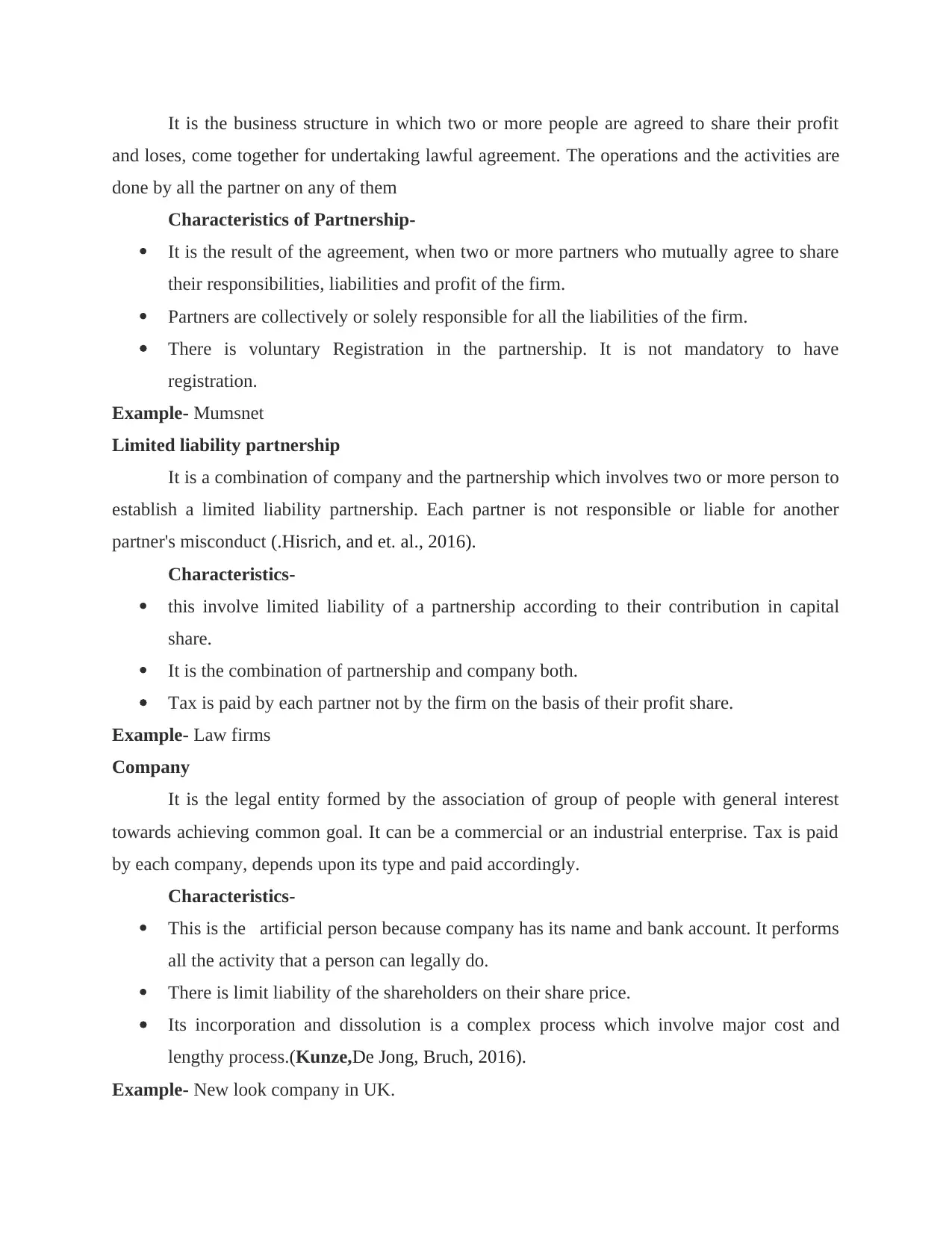
It is the business structure in which two or more people are agreed to share their profit
and loses, come together for undertaking lawful agreement. The operations and the activities are
done by all the partner on any of them
Characteristics of Partnership-
It is the result of the agreement, when two or more partners who mutually agree to share
their responsibilities, liabilities and profit of the firm.
Partners are collectively or solely responsible for all the liabilities of the firm.
There is voluntary Registration in the partnership. It is not mandatory to have
registration.
Example- Mumsnet
Limited liability partnership
It is a combination of company and the partnership which involves two or more person to
establish a limited liability partnership. Each partner is not responsible or liable for another
partner's misconduct (.Hisrich, and et. al., 2016).
Characteristics-
this involve limited liability of a partnership according to their contribution in capital
share.
It is the combination of partnership and company both.
Tax is paid by each partner not by the firm on the basis of their profit share.
Example- Law firms
Company
It is the legal entity formed by the association of group of people with general interest
towards achieving common goal. It can be a commercial or an industrial enterprise. Tax is paid
by each company, depends upon its type and paid accordingly.
Characteristics-
This is the artificial person because company has its name and bank account. It performs
all the activity that a person can legally do.
There is limit liability of the shareholders on their share price.
Its incorporation and dissolution is a complex process which involve major cost and
lengthy process.(Kunze,De Jong, Bruch, 2016).
Example- New look company in UK.
and loses, come together for undertaking lawful agreement. The operations and the activities are
done by all the partner on any of them
Characteristics of Partnership-
It is the result of the agreement, when two or more partners who mutually agree to share
their responsibilities, liabilities and profit of the firm.
Partners are collectively or solely responsible for all the liabilities of the firm.
There is voluntary Registration in the partnership. It is not mandatory to have
registration.
Example- Mumsnet
Limited liability partnership
It is a combination of company and the partnership which involves two or more person to
establish a limited liability partnership. Each partner is not responsible or liable for another
partner's misconduct (.Hisrich, and et. al., 2016).
Characteristics-
this involve limited liability of a partnership according to their contribution in capital
share.
It is the combination of partnership and company both.
Tax is paid by each partner not by the firm on the basis of their profit share.
Example- Law firms
Company
It is the legal entity formed by the association of group of people with general interest
towards achieving common goal. It can be a commercial or an industrial enterprise. Tax is paid
by each company, depends upon its type and paid accordingly.
Characteristics-
This is the artificial person because company has its name and bank account. It performs
all the activity that a person can legally do.
There is limit liability of the shareholders on their share price.
Its incorporation and dissolution is a complex process which involve major cost and
lengthy process.(Kunze,De Jong, Bruch, 2016).
Example- New look company in UK.
⊘ This is a preview!⊘
Do you want full access?
Subscribe today to unlock all pages.

Trusted by 1+ million students worldwide
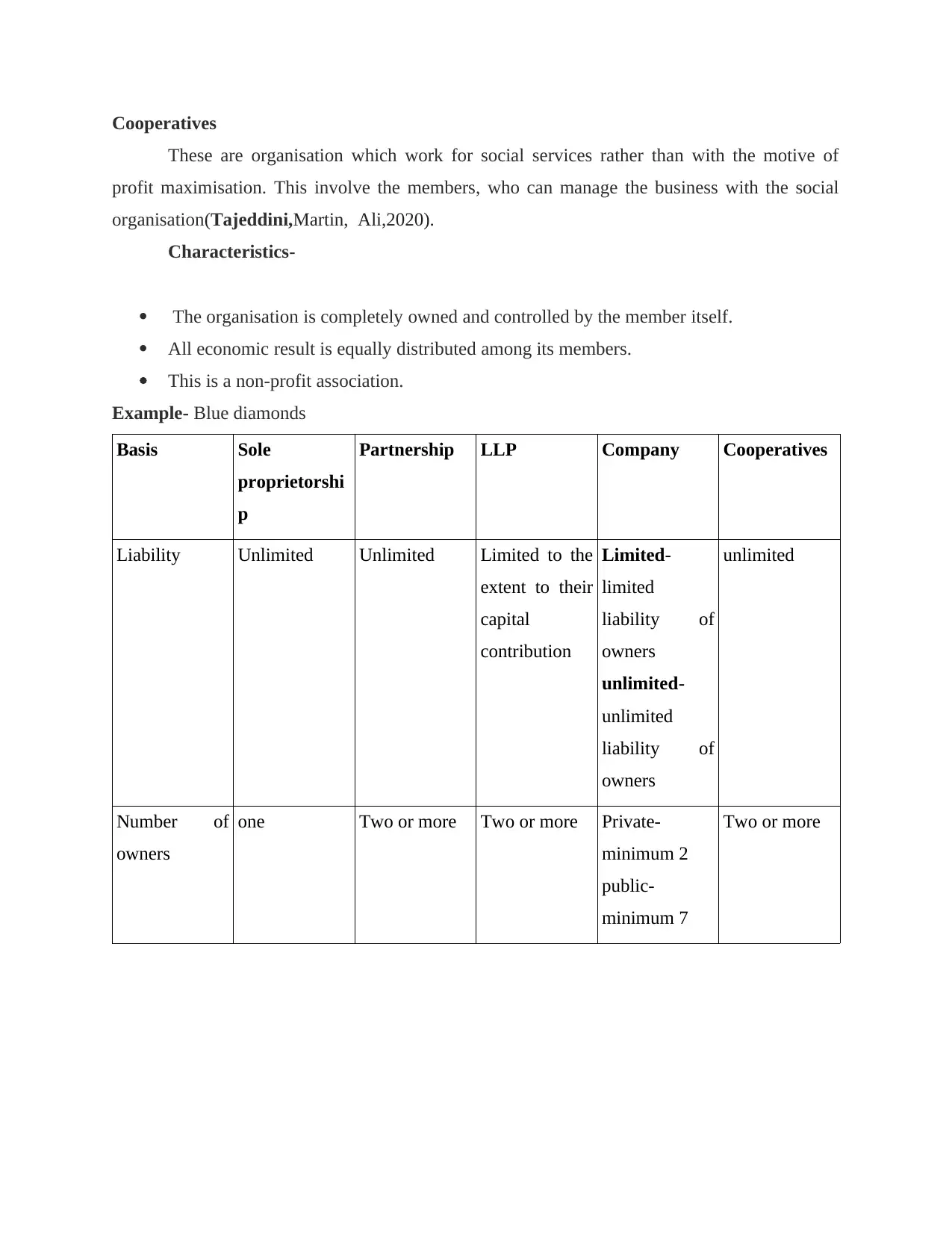
Cooperatives
These are organisation which work for social services rather than with the motive of
profit maximisation. This involve the members, who can manage the business with the social
organisation(Tajeddini,Martin, Ali,2020).
Characteristics-
The organisation is completely owned and controlled by the member itself.
All economic result is equally distributed among its members.
This is a non-profit association.
Example- Blue diamonds
Basis Sole
proprietorshi
p
Partnership LLP Company Cooperatives
Liability Unlimited Unlimited Limited to the
extent to their
capital
contribution
Limited-
limited
liability of
owners
unlimited-
unlimited
liability of
owners
unlimited
Number of
owners
one Two or more Two or more Private-
minimum 2
public-
minimum 7
Two or more
These are organisation which work for social services rather than with the motive of
profit maximisation. This involve the members, who can manage the business with the social
organisation(Tajeddini,Martin, Ali,2020).
Characteristics-
The organisation is completely owned and controlled by the member itself.
All economic result is equally distributed among its members.
This is a non-profit association.
Example- Blue diamonds
Basis Sole
proprietorshi
p
Partnership LLP Company Cooperatives
Liability Unlimited Unlimited Limited to the
extent to their
capital
contribution
Limited-
limited
liability of
owners
unlimited-
unlimited
liability of
owners
unlimited
Number of
owners
one Two or more Two or more Private-
minimum 2
public-
minimum 7
Two or more
Paraphrase This Document
Need a fresh take? Get an instant paraphrase of this document with our AI Paraphraser
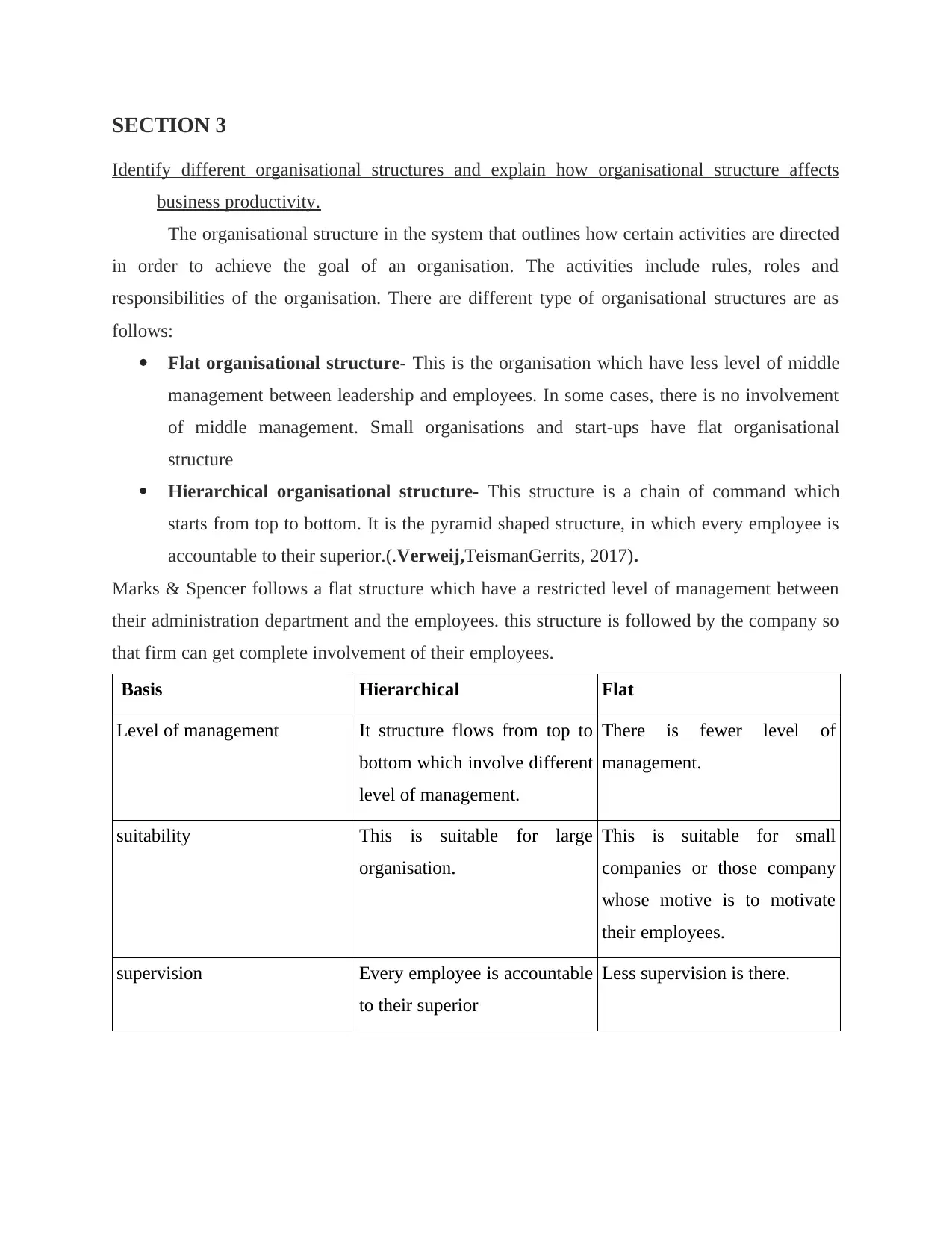
SECTION 3
Identify different organisational structures and explain how organisational structure affects
business productivity.
The organisational structure in the system that outlines how certain activities are directed
in order to achieve the goal of an organisation. The activities include rules, roles and
responsibilities of the organisation. There are different type of organisational structures are as
follows:
Flat organisational structure- This is the organisation which have less level of middle
management between leadership and employees. In some cases, there is no involvement
of middle management. Small organisations and start-ups have flat organisational
structure
Hierarchical organisational structure- This structure is a chain of command which
starts from top to bottom. It is the pyramid shaped structure, in which every employee is
accountable to their superior.(.Verweij,TeismanGerrits, 2017).
Marks & Spencer follows a flat structure which have a restricted level of management between
their administration department and the employees. this structure is followed by the company so
that firm can get complete involvement of their employees.
Basis Hierarchical Flat
Level of management It structure flows from top to
bottom which involve different
level of management.
There is fewer level of
management.
suitability This is suitable for large
organisation.
This is suitable for small
companies or those company
whose motive is to motivate
their employees.
supervision Every employee is accountable
to their superior
Less supervision is there.
Identify different organisational structures and explain how organisational structure affects
business productivity.
The organisational structure in the system that outlines how certain activities are directed
in order to achieve the goal of an organisation. The activities include rules, roles and
responsibilities of the organisation. There are different type of organisational structures are as
follows:
Flat organisational structure- This is the organisation which have less level of middle
management between leadership and employees. In some cases, there is no involvement
of middle management. Small organisations and start-ups have flat organisational
structure
Hierarchical organisational structure- This structure is a chain of command which
starts from top to bottom. It is the pyramid shaped structure, in which every employee is
accountable to their superior.(.Verweij,TeismanGerrits, 2017).
Marks & Spencer follows a flat structure which have a restricted level of management between
their administration department and the employees. this structure is followed by the company so
that firm can get complete involvement of their employees.
Basis Hierarchical Flat
Level of management It structure flows from top to
bottom which involve different
level of management.
There is fewer level of
management.
suitability This is suitable for large
organisation.
This is suitable for small
companies or those company
whose motive is to motivate
their employees.
supervision Every employee is accountable
to their superior
Less supervision is there.
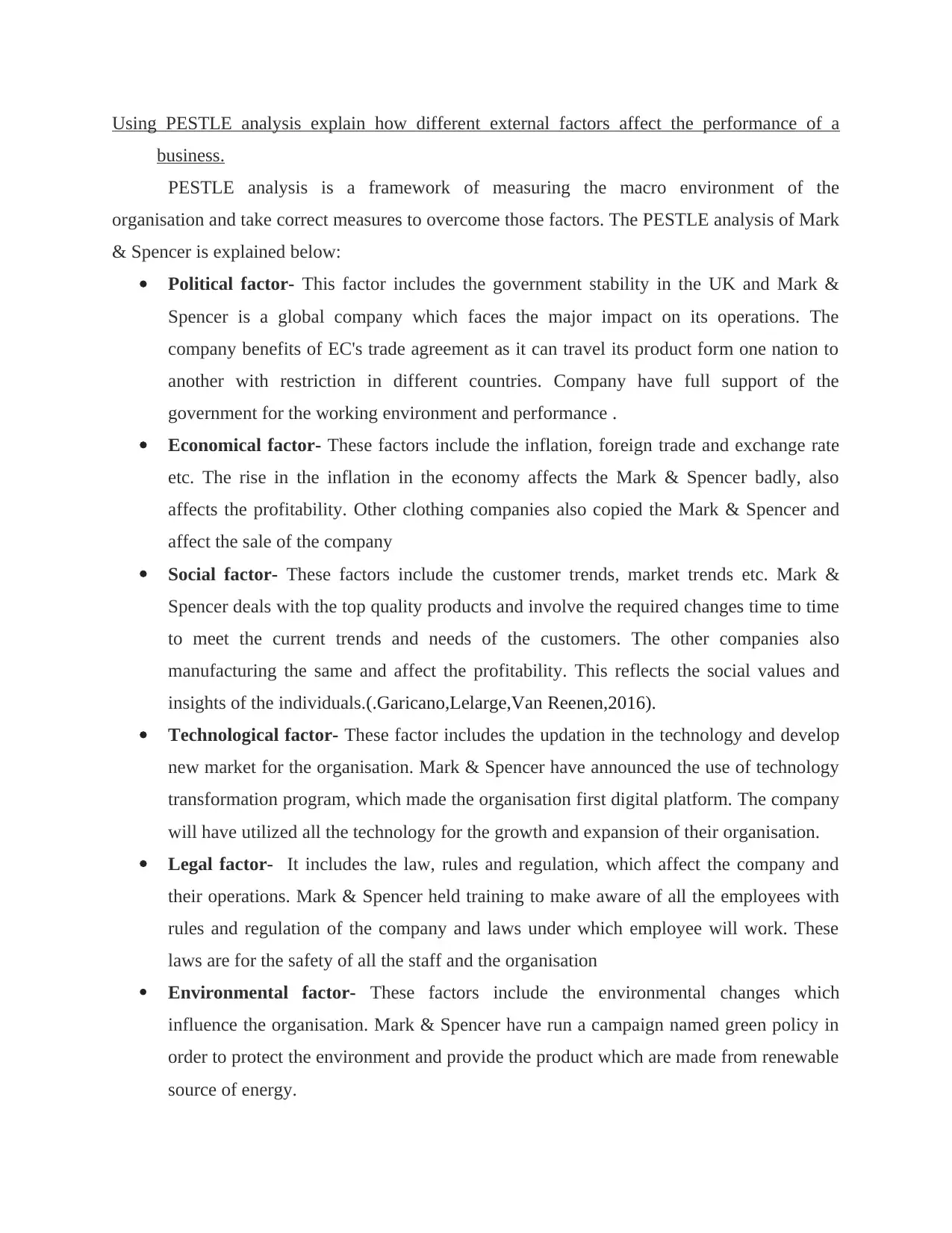
Using PESTLE analysis explain how different external factors affect the performance of a
business.
PESTLE analysis is a framework of measuring the macro environment of the
organisation and take correct measures to overcome those factors. The PESTLE analysis of Mark
& Spencer is explained below:
Political factor- This factor includes the government stability in the UK and Mark &
Spencer is a global company which faces the major impact on its operations. The
company benefits of EC's trade agreement as it can travel its product form one nation to
another with restriction in different countries. Company have full support of the
government for the working environment and performance .
Economical factor- These factors include the inflation, foreign trade and exchange rate
etc. The rise in the inflation in the economy affects the Mark & Spencer badly, also
affects the profitability. Other clothing companies also copied the Mark & Spencer and
affect the sale of the company
Social factor- These factors include the customer trends, market trends etc. Mark &
Spencer deals with the top quality products and involve the required changes time to time
to meet the current trends and needs of the customers. The other companies also
manufacturing the same and affect the profitability. This reflects the social values and
insights of the individuals.(.Garicano,Lelarge,Van Reenen,2016).
Technological factor- These factor includes the updation in the technology and develop
new market for the organisation. Mark & Spencer have announced the use of technology
transformation program, which made the organisation first digital platform. The company
will have utilized all the technology for the growth and expansion of their organisation.
Legal factor- It includes the law, rules and regulation, which affect the company and
their operations. Mark & Spencer held training to make aware of all the employees with
rules and regulation of the company and laws under which employee will work. These
laws are for the safety of all the staff and the organisation
Environmental factor- These factors include the environmental changes which
influence the organisation. Mark & Spencer have run a campaign named green policy in
order to protect the environment and provide the product which are made from renewable
source of energy.
business.
PESTLE analysis is a framework of measuring the macro environment of the
organisation and take correct measures to overcome those factors. The PESTLE analysis of Mark
& Spencer is explained below:
Political factor- This factor includes the government stability in the UK and Mark &
Spencer is a global company which faces the major impact on its operations. The
company benefits of EC's trade agreement as it can travel its product form one nation to
another with restriction in different countries. Company have full support of the
government for the working environment and performance .
Economical factor- These factors include the inflation, foreign trade and exchange rate
etc. The rise in the inflation in the economy affects the Mark & Spencer badly, also
affects the profitability. Other clothing companies also copied the Mark & Spencer and
affect the sale of the company
Social factor- These factors include the customer trends, market trends etc. Mark &
Spencer deals with the top quality products and involve the required changes time to time
to meet the current trends and needs of the customers. The other companies also
manufacturing the same and affect the profitability. This reflects the social values and
insights of the individuals.(.Garicano,Lelarge,Van Reenen,2016).
Technological factor- These factor includes the updation in the technology and develop
new market for the organisation. Mark & Spencer have announced the use of technology
transformation program, which made the organisation first digital platform. The company
will have utilized all the technology for the growth and expansion of their organisation.
Legal factor- It includes the law, rules and regulation, which affect the company and
their operations. Mark & Spencer held training to make aware of all the employees with
rules and regulation of the company and laws under which employee will work. These
laws are for the safety of all the staff and the organisation
Environmental factor- These factors include the environmental changes which
influence the organisation. Mark & Spencer have run a campaign named green policy in
order to protect the environment and provide the product which are made from renewable
source of energy.
⊘ This is a preview!⊘
Do you want full access?
Subscribe today to unlock all pages.

Trusted by 1+ million students worldwide
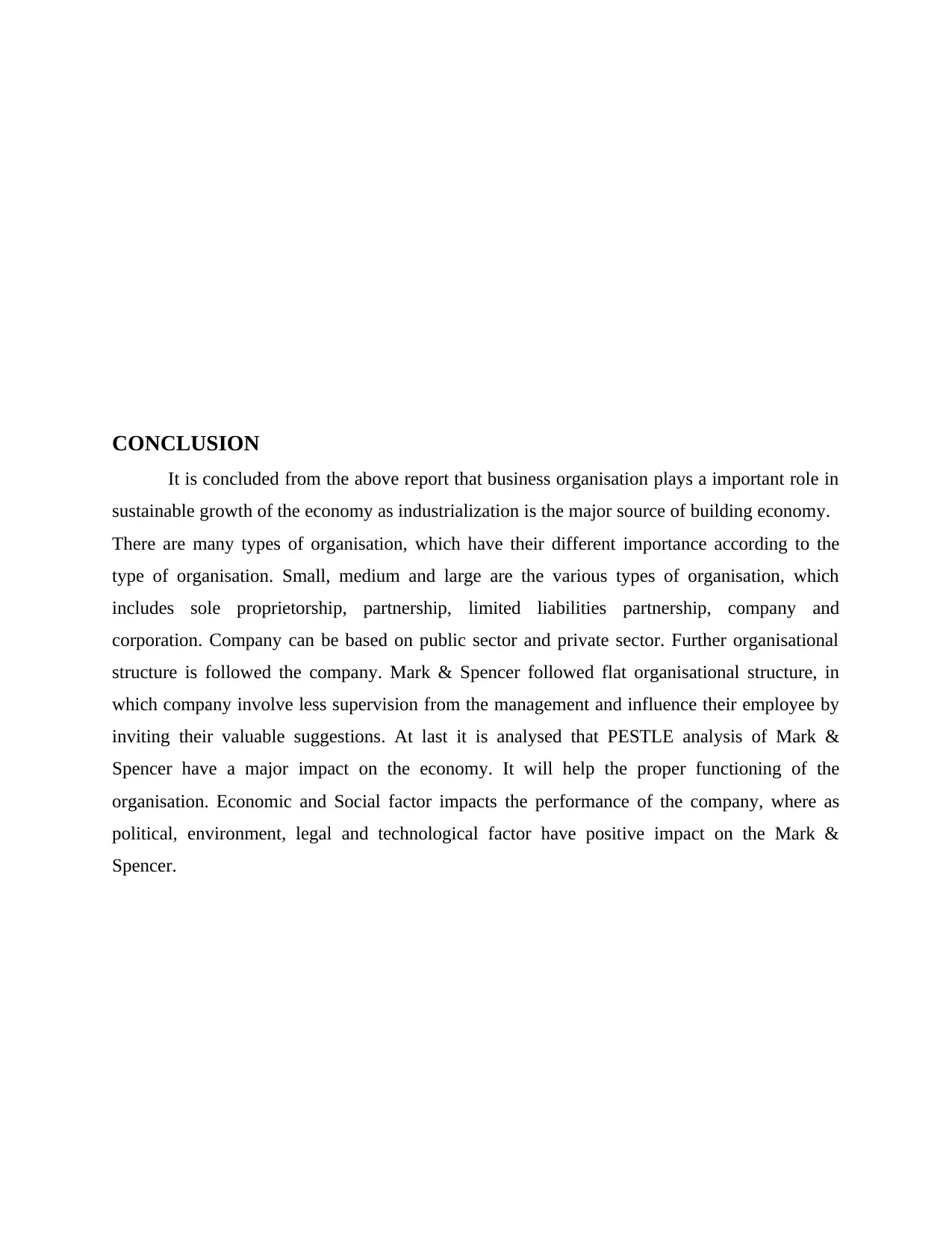
CONCLUSION
It is concluded from the above report that business organisation plays a important role in
sustainable growth of the economy as industrialization is the major source of building economy.
There are many types of organisation, which have their different importance according to the
type of organisation. Small, medium and large are the various types of organisation, which
includes sole proprietorship, partnership, limited liabilities partnership, company and
corporation. Company can be based on public sector and private sector. Further organisational
structure is followed the company. Mark & Spencer followed flat organisational structure, in
which company involve less supervision from the management and influence their employee by
inviting their valuable suggestions. At last it is analysed that PESTLE analysis of Mark &
Spencer have a major impact on the economy. It will help the proper functioning of the
organisation. Economic and Social factor impacts the performance of the company, where as
political, environment, legal and technological factor have positive impact on the Mark &
Spencer.
It is concluded from the above report that business organisation plays a important role in
sustainable growth of the economy as industrialization is the major source of building economy.
There are many types of organisation, which have their different importance according to the
type of organisation. Small, medium and large are the various types of organisation, which
includes sole proprietorship, partnership, limited liabilities partnership, company and
corporation. Company can be based on public sector and private sector. Further organisational
structure is followed the company. Mark & Spencer followed flat organisational structure, in
which company involve less supervision from the management and influence their employee by
inviting their valuable suggestions. At last it is analysed that PESTLE analysis of Mark &
Spencer have a major impact on the economy. It will help the proper functioning of the
organisation. Economic and Social factor impacts the performance of the company, where as
political, environment, legal and technological factor have positive impact on the Mark &
Spencer.
Paraphrase This Document
Need a fresh take? Get an instant paraphrase of this document with our AI Paraphraser
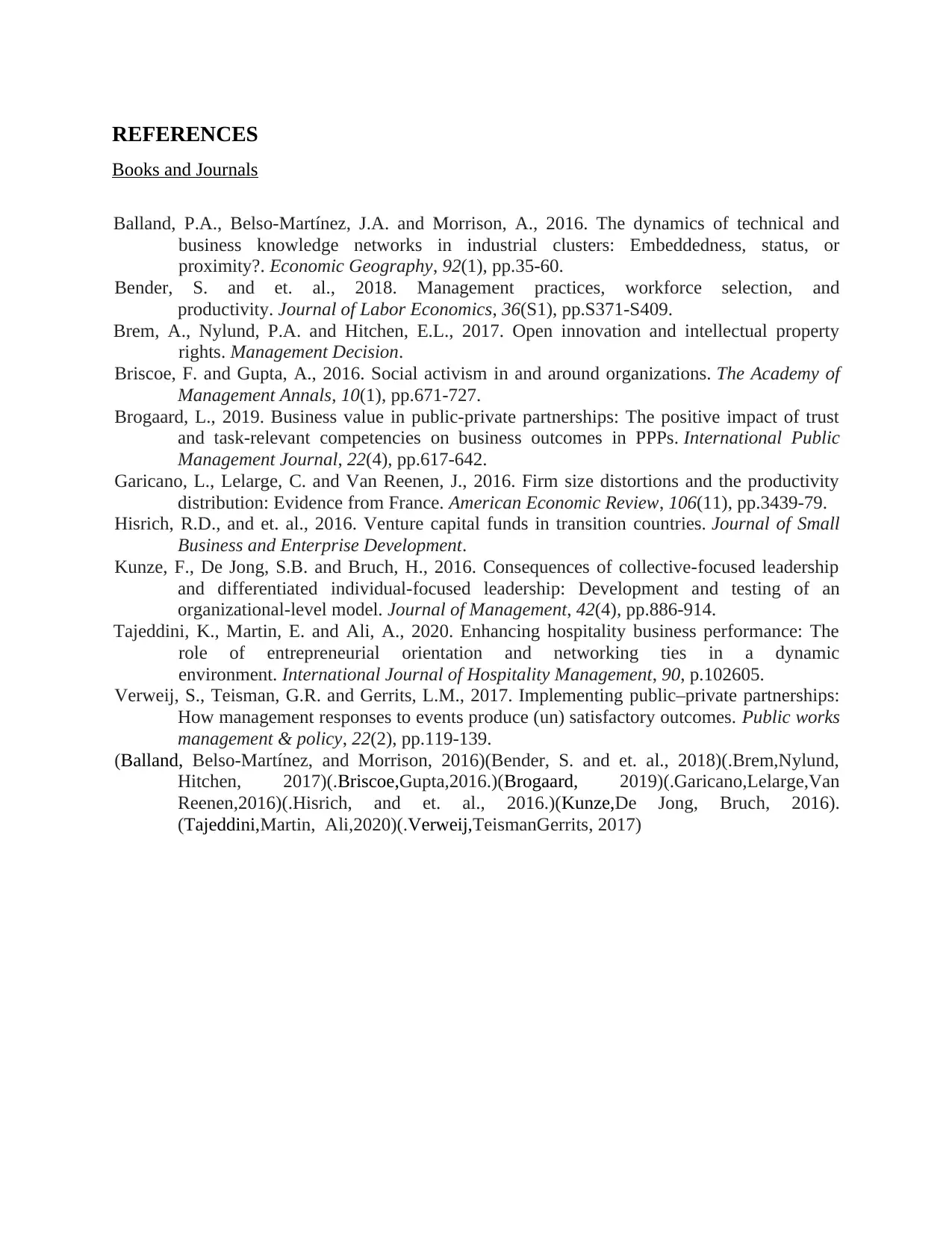
REFERENCES
Books and Journals
Balland, P.A., Belso-Martínez, J.A. and Morrison, A., 2016. The dynamics of technical and
business knowledge networks in industrial clusters: Embeddedness, status, or
proximity?. Economic Geography, 92(1), pp.35-60.
Bender, S. and et. al., 2018. Management practices, workforce selection, and
productivity. Journal of Labor Economics, 36(S1), pp.S371-S409.
Brem, A., Nylund, P.A. and Hitchen, E.L., 2017. Open innovation and intellectual property
rights. Management Decision.
Briscoe, F. and Gupta, A., 2016. Social activism in and around organizations. The Academy of
Management Annals, 10(1), pp.671-727.
Brogaard, L., 2019. Business value in public-private partnerships: The positive impact of trust
and task-relevant competencies on business outcomes in PPPs. International Public
Management Journal, 22(4), pp.617-642.
Garicano, L., Lelarge, C. and Van Reenen, J., 2016. Firm size distortions and the productivity
distribution: Evidence from France. American Economic Review, 106(11), pp.3439-79.
Hisrich, R.D., and et. al., 2016. Venture capital funds in transition countries. Journal of Small
Business and Enterprise Development.
Kunze, F., De Jong, S.B. and Bruch, H., 2016. Consequences of collective-focused leadership
and differentiated individual-focused leadership: Development and testing of an
organizational-level model. Journal of Management, 42(4), pp.886-914.
Tajeddini, K., Martin, E. and Ali, A., 2020. Enhancing hospitality business performance: The
role of entrepreneurial orientation and networking ties in a dynamic
environment. International Journal of Hospitality Management, 90, p.102605.
Verweij, S., Teisman, G.R. and Gerrits, L.M., 2017. Implementing public–private partnerships:
How management responses to events produce (un) satisfactory outcomes. Public works
management & policy, 22(2), pp.119-139.
(Balland, Belso-Martínez, and Morrison, 2016)(Bender, S. and et. al., 2018)(.Brem,Nylund,
Hitchen, 2017)(.Briscoe,Gupta,2016.)(Brogaard, 2019)(.Garicano,Lelarge,Van
Reenen,2016)(.Hisrich, and et. al., 2016.)(Kunze,De Jong, Bruch, 2016).
(Tajeddini,Martin, Ali,2020)(.Verweij,TeismanGerrits, 2017)
Books and Journals
Balland, P.A., Belso-Martínez, J.A. and Morrison, A., 2016. The dynamics of technical and
business knowledge networks in industrial clusters: Embeddedness, status, or
proximity?. Economic Geography, 92(1), pp.35-60.
Bender, S. and et. al., 2018. Management practices, workforce selection, and
productivity. Journal of Labor Economics, 36(S1), pp.S371-S409.
Brem, A., Nylund, P.A. and Hitchen, E.L., 2017. Open innovation and intellectual property
rights. Management Decision.
Briscoe, F. and Gupta, A., 2016. Social activism in and around organizations. The Academy of
Management Annals, 10(1), pp.671-727.
Brogaard, L., 2019. Business value in public-private partnerships: The positive impact of trust
and task-relevant competencies on business outcomes in PPPs. International Public
Management Journal, 22(4), pp.617-642.
Garicano, L., Lelarge, C. and Van Reenen, J., 2016. Firm size distortions and the productivity
distribution: Evidence from France. American Economic Review, 106(11), pp.3439-79.
Hisrich, R.D., and et. al., 2016. Venture capital funds in transition countries. Journal of Small
Business and Enterprise Development.
Kunze, F., De Jong, S.B. and Bruch, H., 2016. Consequences of collective-focused leadership
and differentiated individual-focused leadership: Development and testing of an
organizational-level model. Journal of Management, 42(4), pp.886-914.
Tajeddini, K., Martin, E. and Ali, A., 2020. Enhancing hospitality business performance: The
role of entrepreneurial orientation and networking ties in a dynamic
environment. International Journal of Hospitality Management, 90, p.102605.
Verweij, S., Teisman, G.R. and Gerrits, L.M., 2017. Implementing public–private partnerships:
How management responses to events produce (un) satisfactory outcomes. Public works
management & policy, 22(2), pp.119-139.
(Balland, Belso-Martínez, and Morrison, 2016)(Bender, S. and et. al., 2018)(.Brem,Nylund,
Hitchen, 2017)(.Briscoe,Gupta,2016.)(Brogaard, 2019)(.Garicano,Lelarge,Van
Reenen,2016)(.Hisrich, and et. al., 2016.)(Kunze,De Jong, Bruch, 2016).
(Tajeddini,Martin, Ali,2020)(.Verweij,TeismanGerrits, 2017)

⊘ This is a preview!⊘
Do you want full access?
Subscribe today to unlock all pages.

Trusted by 1+ million students worldwide
1 out of 12
Related Documents
Your All-in-One AI-Powered Toolkit for Academic Success.
+13062052269
info@desklib.com
Available 24*7 on WhatsApp / Email
![[object Object]](/_next/static/media/star-bottom.7253800d.svg)
Unlock your academic potential
Copyright © 2020–2025 A2Z Services. All Rights Reserved. Developed and managed by ZUCOL.





